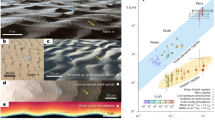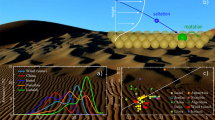Abstract
Field studies of barchans—crescent-shaped dunes that propagate over solid ground under conditions of unidirectional wind1—have long focused on the investigation of an equilibrium between sand transport by wind and the control of air flow by dune topography2,3,4, which are thought to control dune morphology and kinematics5,6,7. Because of the long timescale involved, however, the underlying dynamic processes responsible for the evolution of dune fields remain poorly understood8. Here we combine data from a three-year field study in the Moroccan Sahara with a model study to show that barchans are fundamentally unstable and do not necessarily behave like stable solitary waves, as suggested previously9,10,11,12. We find that dune collisions and changes in wind direction destabilize the dunes and generate surface waves on the barchans. Because the resulting surface waves propagate at a higher speed than the dunes themselves, they can produce a series of new barchans of elementary size by breaking the horns of large dunes. The creation of these new dunes provides a mechanism for sand loss that prevents dune fields from merging into a single giant dune and therefore plays a fundamental role in the control of size selection and the development of dune patterns.
This is a preview of subscription content, access via your institution
Access options
Subscribe to this journal
Receive 51 print issues and online access
$199.00 per year
only $3.90 per issue
Buy this article
- Purchase on Springer Link
- Instant access to full article PDF
Prices may be subject to local taxes which are calculated during checkout



Similar content being viewed by others
References
Bagnold, R. A. The Physics of Blown Sand and Desert Dunes (Methuen, London, 1941)
Wiggs, G. F. S., Livingstone, I. & Warren, A. The role of streamline curvature in sand dune dynamics: evidence from field and wind tunnel measurements. Geomorphology 17, 29–46 (1996)
Lancaster, N., Nickling, W. G., McKenna-Neuman, C. K. & Wyatt, V. E. Sediment flux and airflow on the stoss slope of a barchan dune. Geomorphology 17, 55–62 (1996)
McKenna-Neuman, C., Lancaster, N. & Nickling, W. G. Relations between dune morphology, air flow, and sediment flux on reversing dunes, Silver Peak, Nevada. Sedimentology 44, 1103–1113 (1997)
Finkel, H. J. The barchans of southern Peru. J. Geol. 67, 614–647 (1959)
Hastenrath, S. L. The barchans of the Arequipa region, southern Peru. Z. Geomorphol. 11, 300–331 (1967)
Andreotti, B., Claudin, P. & Douady, S. Selection of dune shapes and velocities—Part 1: Dynamics of sand, wind and barchans. Eur. Phys. J. B 28, 321–339 (2002)
Hersen, P. et al. Corridors of barchan dunes: stability and size selection. Phys. Rev. E 69, 011304 (2004)
Besler, H. Complex barchans in the Libyan Desert: dune traps or overtaking solitons? Z. Geomorph. N.F. Suppl.-Bd. 126, 59–74 (2002)
Schwammle, V. & Herrmann, H. J. Solitary wave behaviour of sand dunes. Nature 426, 619–620 (2003)
Katsuki, A., Nishimori, H., Endo, N. & Taniguchi, K. Collision dynamics of two barchan dunes simulated by a simple model. J. Phys. Soc. Jpn 74, 538–541; preprint at http://arXiv.org/cond-mat/0403312 (2005)
Livingstone, I., Wiggs, G. F. S. & Baddock, M. Barchan dunes: why they cannot be treated as solitons or solitary waves. Earth Surf. Process. Landforms 30, 255–257 (2005)
Fryberger, S. G. & Dean, G. in A Study of Global Sand Seas (ed. McKee, E. D.) 137–169 (Geol. Surv. Prof. Pap. 1052, Washington, 1979)
Hersen, P., Douady, S. & Andreotti, B. Relevant length scale of barchan dunes. Phys. Rev. Lett. 89, 264301 (2002)
Andreotti, B. A two-species model of aeolian sand transport. J. Fluid Mech. 510, 47–70 (2004)
Huerre, P. & Monkewitz, P. P. Local and global instabilities in spatially developing flows. Annu. Rev. Fluid Mech. 22, 473–537 (1990)
European Space Agency. Mars Expresshttp://www.esa.int/SPECIALS/Mars_Express/ (23 June 2005).
Mars Rover Blog. Mars Rover Photoshttp://www.markcarey.com/mars/mars-rover-photos.html (23 June 2005).
Acknowledgements
We thank H. Bellot and L. Quartier for assistance during field measurements, R. Hoyle, B. Murray and J. Snoeijer for critical reading of the manuscript, and H. Tsoar for the provision of sand roses. This study was supported by an ACI Jeunes Chercheurs.
Author information
Authors and Affiliations
Corresponding author
Ethics declarations
Competing interests
Reprints and permissions information is available at npg.nature.com/reprintsandpermissions. The authors declare no competing financial interests.
Supplementary information
Supplementary Notes
This file contains Supplementary Methods, Supplementary Table S1 and Supplementary Figures. (PDF 732 kb)
Rights and permissions
About this article
Cite this article
Elbelrhiti, H., Claudin, P. & Andreotti, B. Field evidence for surface-wave-induced instability of sand dunes. Nature 437, 720–723 (2005). https://doi.org/10.1038/nature04058
Received:
Accepted:
Issue Date:
DOI: https://doi.org/10.1038/nature04058
This article is cited by
-
Coevolving aerodynamic and impact ripples on Earth
Nature Geoscience (2024)
-
Assessing the spatiotemporal transformation of a coastal lagoon inlet (1984–2019) using remote sensing and GIS: a study of Khenifiss Lagoon in Southern Morocco
Environmental Earth Sciences (2024)
-
Morphologic changes of simple star dunes during the growth process in Dunhuang, China
Journal of Mountain Science (2022)
-
Soil map of Khnifiss lagoon and its surrounding environment
Arabian Journal of Geosciences (2021)
-
Pattern analysis and dating for the Badain Jaran dune field, northwestern China
Environmental Earth Sciences (2020)
Comments
By submitting a comment you agree to abide by our Terms and Community Guidelines. If you find something abusive or that does not comply with our terms or guidelines please flag it as inappropriate.



